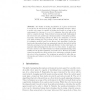246 search results - page 14 / 50 » Navigating Mobile Robots: Sensors and Techniques |
ROBOTICA
2006
13 years 8 months ago
2006
We combine a "hybrid" force/position control scheme with a potential field approach into a novel method for collision recovery and navigation in unknown environments. It...
IROS
2006
IEEE
14 years 2 months ago
2006
IEEE
— Current approaches to the visual homing for mobile robot navigation are generally inspired in insects’ behavior and based on the observed angular information of fixed points...
IBPRIA
2005
Springer
14 years 2 months ago
2005
Springer
The ability of finding its situation in a given environment is crucial for an autonomous agent. While navigating through a space, a mobile robot must be capable of finding its lo...
ICRA
2002
IEEE
14 years 1 months ago
2002
IEEE
Mobile robot localization from large-scale appearance mosaics has been showing increasing promise as a low-cost, high-performance and infrastructure-free solution to vehicle guida...
ICRA
1993
IEEE
14 years 27 days ago
1993
IEEE
An issue central to the navigation problem is memory. Traditional systems build symbolic maps of the world for navigational reference. Reactive methods, in contrast, eliminate or m...

